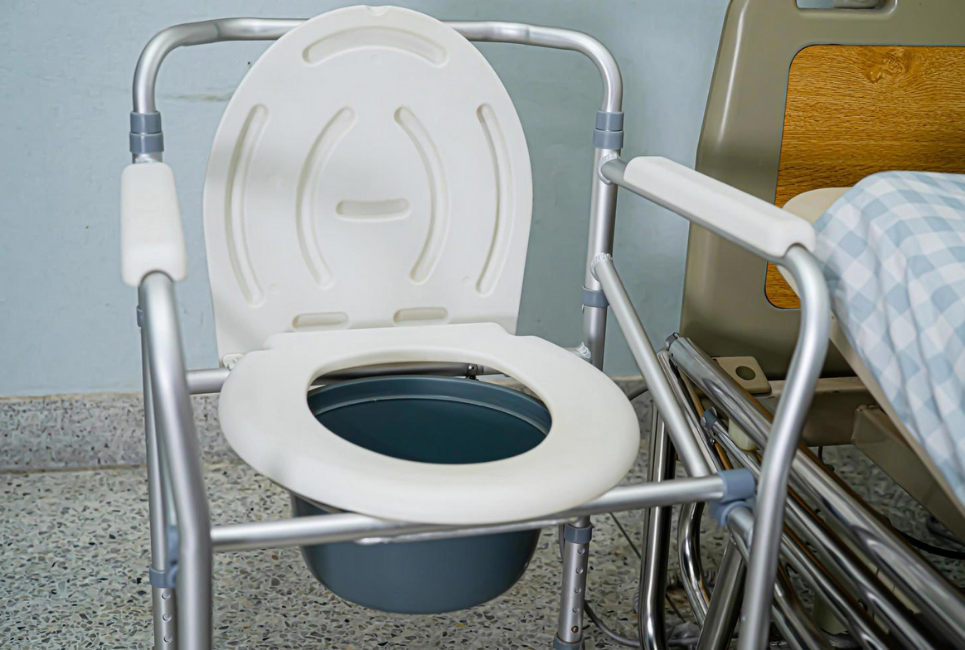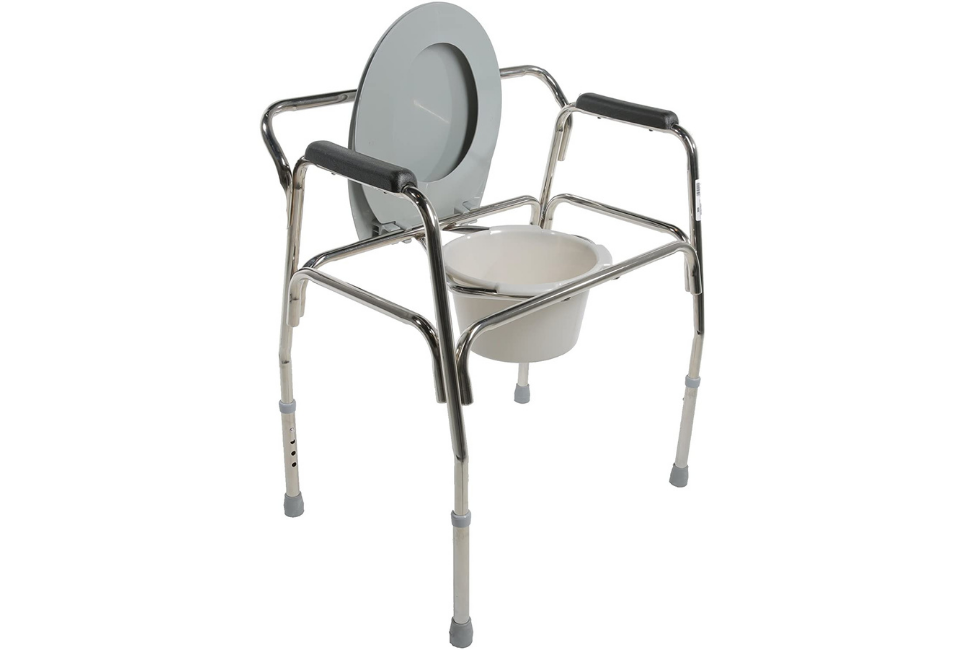- Best Transport Wheelchairs Guide - October 13, 2021
Living with an aged person or a disabled loved one can be challenging. Still, the task becomes more complicated when dealing with incontinence or physical disabilities that make using the toilet a hurdle. This problem can lead to accidents, which are physically uncomfortable and often deteriorate the emotional and mental state of the patient and their caregivers.
Commodes are an ideal solution for such situations. These products are sturdy and relatively easy to use. They are also comfortable, allowing the user to remain in a dignified position as they go about their business. However, finding the optimal commode for a loved one requires going through a range of products to find the best.
While there are many types of commodes, ultimately, the best solution depends on the needs and conditions of your loved one. It’s easy to feel overwhelmed at the prospect of searching for a commode. After all, they come in an array of variations and qualities. This article will take you through all you need to know about finding the best commode for your loved one’s needs.
What are Commodes?
Commodes are a type of toilet designed for use by people with extreme mobility issues. Instead of sitting atop a toilet seat, commode users sit on a raised seat with armrests and a flat base. A commode features four legs and a removable, sometimes disposable pan for urine and solid waste.
A lid covers the pan, giving the commode a more sanitary feel. Most models also come with a foot lever that the user can step on to raise and lower the seat as needed easily. The best commodes are sturdy, durable, and easy to use.

Why Should You Buy a Commode?
Physical disabilities and conditions that limit mobility can make using the toilet a challenge. These issues often worsen with bowel movements, as those with limited mobility have difficulty reaching a standard bathroom.
For this reason, commodes represent an ideal solution for many people. They allow users to go about their business in privacy and dignity while feeling safe and comfortable. And, as some models feature removable pans for easy cleaning, going to the bathroom can be more accessible than ever.
Below are the top reasons a commode may be necessary:
- Commodes ensure ultimate safety and comfort.
- It’s easier to transfer a person from a wheelchair to a commode than a standard toilet.
- Using an elevated seat can help those with limited mobility or stamina control their bowel movements.
- Commodes make going to the bathroom more private and dignified.
Who Needs a Commode?
Commodes are built with the needs of the elderly, the chronically ill, and people with extreme physical disabilities in mind. These products are helpful for anyone who finds moving to the bathroom or lifting themselves off the toilet a challenge.
People with these needs might include:
- Senior patients who have been diagnosed with arthritis, stroke, Parkinson’s disease, falls, dehydration, diabetes, and other severe conditions.
- People recovering from hip surgery or knee replacement surgery may find it takes a long time to use the toilet.
- Families caring for Alzheimer’s patients often need to make using the bathroom more accessible.
- People with limited mobility or stamina may struggle to use a standard toilet, making commodes an ideal solution.
Before settling on a particular commode, you must identify the needs of your loved one. The most efficient commode will depend on the physical conditions of the user in question. For instance, an obese person may find a bariatric commode more comfortable than a standard bedside commode.
Types of Commodes
Commodes come in a variety of types. While they serve the same purpose, each type of commode has unique benefits. Different models come with their own set of pros and cons. The commodes have different features to help users with specific needs.
There are four main types of commode chairs:
- Bedside commode chairs
- Transfer commode chair
- Over the toilet commode chair
- Shower commode chair
Bedside Commode Chairs
A quick rush to the toilet is inconvenient when one is confined to bed. Unfortunately, toileting while in bed is inevitable for many people. Bedside commodes are ideal for such circumstances. They are handy for people who spend most of their time in bed and those who are not mobile without help.
As the name suggests, the commode is best used near a bed. Notably, these commodes are ideal for people who have suffered strokes or accidents. Bedside commodes provide users with support and relief, enabling them to use the toilet with little to no help.
You can strategically place the commode next to your loved one’s bed so they can use it safely and comfortably. Make sure the commode is stable and securely out of reach from your loved one to avoid any accidents or falls.
When choosing among the best bedside commodes, select a model that best meets your loved one’s needs. Consider factors such as the mobility of the device. Does it have drop arms for easy entry and exit? Is it on casters so they can easily move to another room? Other features include weight capacity, adjustability, and durability.
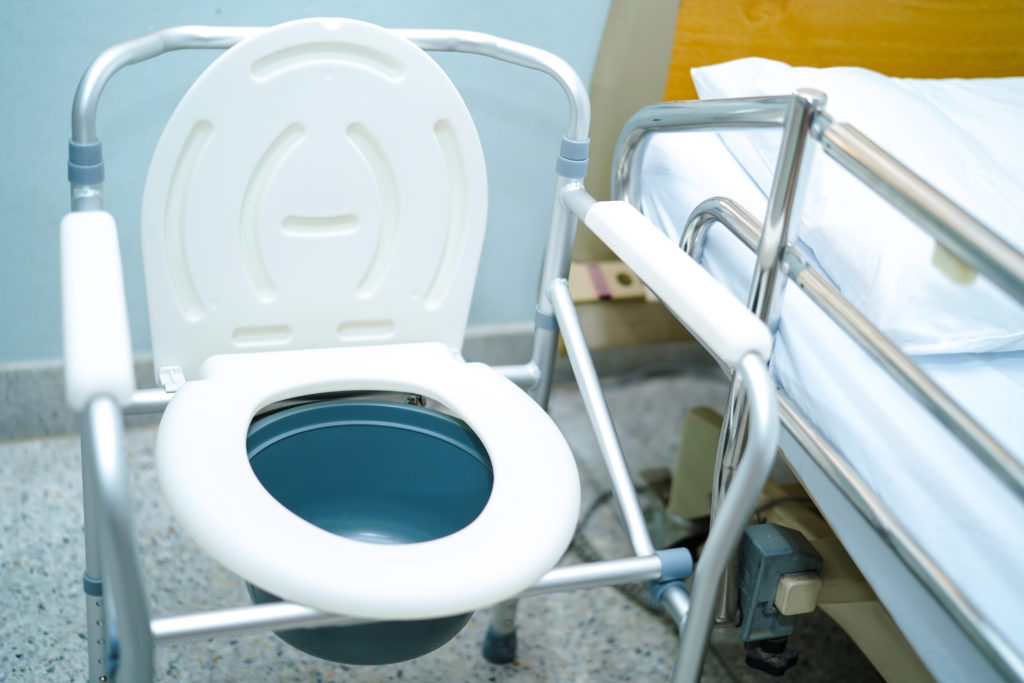
Transfer Commode Chair
Older persons and those with extreme mobility issues face challenges moving from one point to another. Transferring to and from chairs, beds, wheelchairs, and even the toilet is difficult for these people. Transfer commodes are designed with this issue in mind. They help seniors transfer to traditional commodes or toilets without help.
The main difference between transfer commode chairs and other commodes is that one of the arms will pivot while the other remains straight. The one that can pivot may slide up and down or lay flat to give users a sturdy platform for transferring into or out of the chair.
The ideal transfer commode chair is easy to assemble and disassemble. The height should be adjustable, especially for taller users. Consider adding a foam protector to prevent pressure sores. The best transfer commode chairs are durable, with removable arms for easy cleaning. Ensure the commode is non-slip with anti-scalding features to avoid slip hazards.
Over the Toilet Commode Chairs
Older people who struggle with getting on and off the toilet may find an ideal solution over the toilet commode chairs. These types of commodes are designed to fit snugly over the toilet seat. Using this type of commode relieves those with problems bending their backs as they sit or stand.
Over the toilet, commode chairs are ideal for seniors who want to maintain independence while caring for their toileting needs. While they are similar to bedside commodes, they are much more practical. Over-the-top commodes feature an open seat that directly attaches to the toilet seat.
The best over the toilet commode chair should have soft padded seats that provide users with comfort and support. The commode should have adjustable height arms with extra padding to prevent pressure sores. It should be easy to clean and remove for thorough wash-downs.
It’s crucial that the chair fits all toilets and is easy to assemble and disassemble. The height should be adjustable, specifically for taller users. Make sure the commode is non-slip with anti-scalding features to avoid slip hazards. Other things to consider include weight capacity, foldability, and storage.

Shower Commode Chair
Taking a bath for older people or those with limited mobility is difficult. It often places unnecessary stress on the body, increasing their risk for falls and other injuries. Consider a shower commode chair if your loved one is aging, recovering from an injury, or has limited mobility. It functions as a traditional commode, but you can also use it in the shower.
Safety is an essential factor when choosing a commode chair. The best shower commodes have slip-resistant features to prevent accidents and falls. Make sure the seat is waterproof and stain-resistant for easy cleaning. It should also be easy to assemble and disassemble, especially if you want to frequently clean it or store it away when not in use.
The ideal material for a shower commode chair is non-corrosive aluminum and stainless steel. A drainage pathway will reduce the chances of infections and make for less frequent cleanups. Ideally, look for a chair with an all-in-one ergonomic design to maximize comfort.
Some shower commode chairs feature wheels to make it easier to move around. Make sure the commode has a weight capacity of at least 300 pounds and is adjustable to accommodate shorter and taller users. The height should be flexible with quick-release levers and locks, with cushioned armrests.
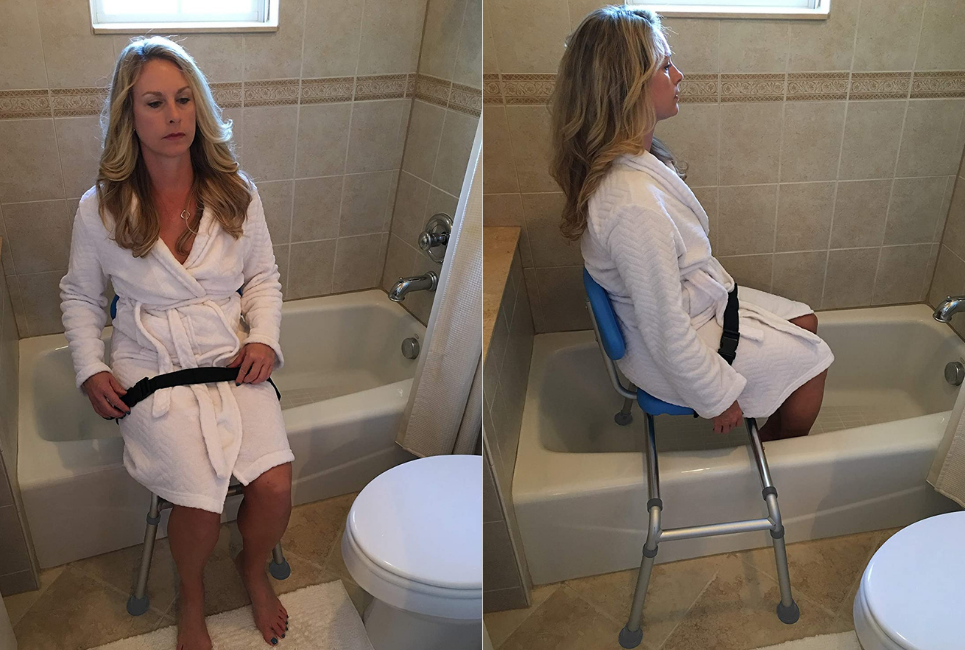
Factors to Consider Before Buying the Best Commode
Several factors go into account when choosing the best commode chair. You want something functional yet comfortable. Below are a few things to consider when shopping around.
1. Adjustability
Ensure the commode is height adjustable to fit shorter and taller users. Ideally, look for a chair with an all-in-one ergonomic design to maximize comfort. The best commodes have armrests that slide up and down and back and forth. This feature provides users with easy accessibility when transferring in or out of the chair, minimizing the risk of falls and injuries.
The overall height of the commode should be adjustable for people with shorter and taller torsos. Look for a seat that is between 17-19 inches high. A higher seat tends to place more pressure on your back, which can cause discomfort after prolonged use.
2. Assembly
The best commodes are easy to assemble and disassemble for storage and cleaning. Ideally, look for a commode with an all-in-one design that is easy to clean. When looking at the assembly, check for screws, rivets, and other visible fixings. If there are any, make sure they are concealed to avoid sharp edges and possible injury.
The commode chair should also be lightweight for easy portability and movement. At the same time, ensure you’re not carrying a rickety chair that is difficult to maneuver. Consider the wheels on the chair, ensuring they are non-corrosive and can lock into place for stability.
3. Material
The material is just as important as the overall design of the chair. For optimal comfort, look for commodes with cushioned padding. The padding will prevent skin irritations that can lead to infections. You should also ensure it’s waterproof, non-corrosive, and easy to clean.
The best materials are aluminum alloy and stainless steel for durability. For added comfort, choose a seat with padding and cushioned armrests. Mold-resistant commodes are ideal for high moisture areas, such as shower stalls and washrooms.
4. Safety Features
One of the primary reasons for having a commode chair is to guarantee maximum safety for your loved ones as they go about their toileting needs. Maximum protection includes slip-resistant features to prevent accidents and falls. Look for commodes with rubberized feet, non-corrosive wheels, and easily adjustable height options.
Note that safety isn’t only about physical comfort. When you’re shopping for a commode chair, look for those with safety and security features such as anti-bacterial construction and safety locks. These safety features ensure hygiene and reduce the risk of contamination and accidents. Look for a chair with antimicrobial construction to minimize the risk of infection.
5. Multipurpose
The best commodes are versatile and allow users to use them in more ways than one. The best 3 in 1 commode allows for use as over-the-toilet commode chairs, shower commode chairs, and bedside commode chairs. Should you decide to invest in a 3 in 1 commode chair, make sure it is lightweight to allow for easy transport from room to room.
Not everyone has the budget for a 3 in 1 commode. For those looking to buy a single chair, look for convertible commodes with removable legs and side panels for bedside commodes. The ideal commode should be able to provide maximum comfort and stability without straining your wallet.
6. Removable Seat
With many commode chairs, it’s necessary to detach the seat to empty the waste. This is especially important for older adults with poor mobility or manual dexterity. A removable seat allows for easy emptying and cleaning. It also helps to keep the commode chair hygienic at all times.
When choosing a commode chair, select one with a seat that is washable and easy to detach. Look for commodes with hinged seats or detachable plastic seats. Ideally, a removable seat should have a secure locking system to prevent sliding off or tipping over.
7. Weight Capacity
Commodes have strict weight limits, which vary from model to model. Choose a commode that can comfortably support the user’s weight without causing discomfort or putting undue stress on the chair.
There are many variations of commodes; while some are bariatric, others are ideal for light and average-weight users. Bariatric commodes are generally sturdier and have higher weight limits. They are suitable for heavy users or overly obese persons.
Accordingly, always choose a commode chair according to the user’s weight. Low-weight capacity chairs are ideal for light or average users, usually not exceeding 300 pounds, while high-weight capacity commode chairs can support up to 1000 pounds of weight.
Notably, bariatric commodes are larger and heavier than standard commodes. While they can be bulky and awkward to move, there’s no arguing that bariatric chairs are sturdier and long-lasting. They support up to 1000 pounds of weight and need only minimal maintenance.
8. Ease of use
When it comes to commodes, ease of use is crucial. You want something that your loved one can comfortably use without the need for assistance. Choose a chair that is easy to climb into and out of while being lightweight enough to move around easily.
Ease of use isn’t just about mobility. Maximum comfort is also a priority when selecting a commode chair. Look for features such as padded armrests and seat cushions to add extra comfort without compromising stability.
Cleaning shouldn’t be an uphill task either. Look for commodes with removable seats, backs, and leg panels for easy cleaning. Some seats come with a detachable plastic seat that is waterproof and easy to clean.
9. Durability
How durable is the commode chair? How long will it last before giving way and needing replacement? Is it worth spending money on the chair? If so, is there a warranty or guarantee to protect against defects and extended periods of use?
Durability is essential when choosing a commode chair. While some models may be cheaper than others, it’s because they’re made with inferior materials and inferior workmanship.
High-quality commodes will last for years of daily use. Look for durable materials such as aluminum frames, stainless steel sides, and waterproof plastic seats. A warranty is proof of quality and durability, so always choose a brand with a good warranty for extended use.
10. Additional Features
When choosing the best commode chair, look for features that increase convenience. Does it have wheels or casters to move around easily? With some models, the seat automatically locks into place when raised; others may come with safety features such as side railings. Many models come with storage baskets or trays for added convenience.
It doesn’t matter how excellent the commode is if it’s not convenient to use. Look for additional features that make using the commode chair a breeze, not a burden.
It should have a seat belt and crotch strap to prevent sliding in the seat. One with a footrest is ideal for users who need to sit on the commode chair for an extended period. For added convenience, choose a model with a padded seat and backrest.
11. Price vs. Value
The debate between price and value is common when buying anything. Commode chairs are generally moderately priced, but high-quality models can be expensive. The user’s needs should dictate the selection, not the budget.
For example, a bariatric commode chair with a 1000-pound weight capacity may cost double that of a standard model without the extra features or durability. However, if the user is heavy or obese, a bariatric chair may last much longer and provide better value for money.
Remember that price doesn’t necessarily equate to quality. Always look at reviews and test models to find the best commode chair regarding durability, weight capacity, ease of use, etc.
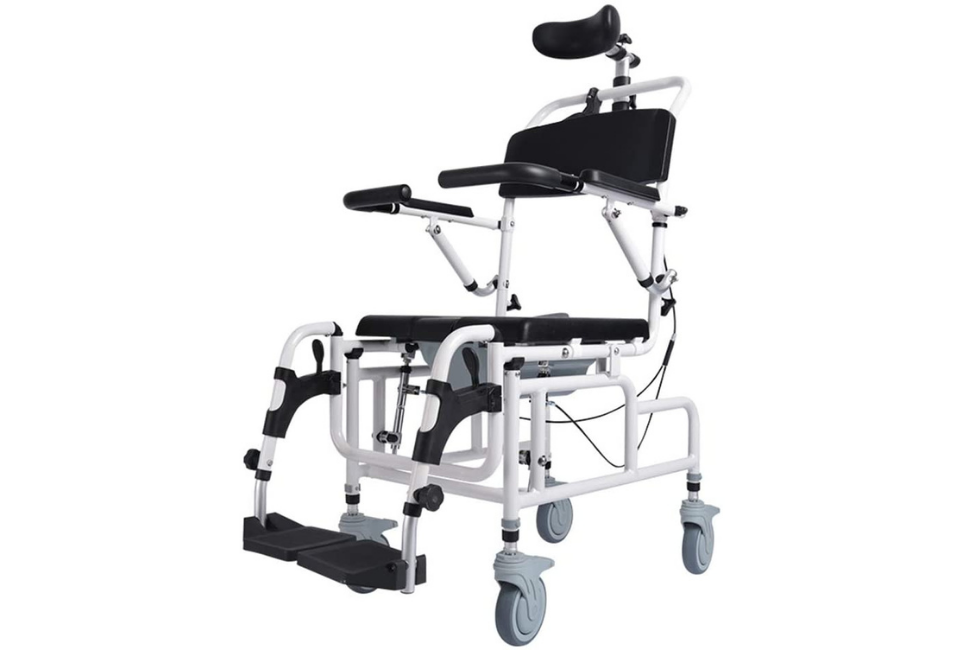
Common Mistakes People Make When Choosing Commodes
Mistakes are common when buying anything for the elderly. Commode chairs are no exception, but they’re easy to avoid if you know what to look out for.
1. Appearance over Comfort
Many people overlook the appearance and buy whatever is cheapest or has the most admirable design. However, an uncomfortable commode chair will make using the bathroom a nightmare. The elderly are already in poor health, so the last thing they want is to be uncomfortable while using the commode.
Avoid the mistake and choose a model that has the best combination of comfort and appearance. If nothing else, keep in mind that it should be easy to clean and move around.
2. Seat Width
Commode chairs come in different sizes, with some having a wider seat than others. This is important because if it’s too narrow, the user may hurt their legs while sitting down. If it’s too wide, there may not be enough support for the back and buttocks when sitting.
For instance, bariatric models usually have wider seats, while standard models are narrower. Always check the measurements of the seat before buying to make sure it’s ideal for the user.
3. Poor cleaning
Regardless of the commode chair’s design or features, it won’t be worth using if it isn’t easy to clean. Keep in mind that some senior patients have difficulty showering and wiping themselves after using the bathroom.
A commode chair with arms is easier to clean than one without arms because it doesn’t need to lift itself into place. For added convenience, choose a model with an odor barrier and drainage hole.
4. Poorly Approximating the Weight Capacity
A common mistake when choosing a commode chair is not looking at the weight capacity. It doesn’t matter how durable or comfortable it is if it breaks while being used. Make sure to consider the user’s weight before buying any commode chair, especially bariatric models.
To avoid any doubts, never buy a model without weight-capacity specifications in the manual. Measure the user’s weight and compare it to the one listed in the manual. If there’s a significant difference, one should look for another model or get a doctor’s opinion.
5. Lack of Accessories
While we all want the additional little things, most people forget to look at them when shopping. For example, some commode chairs come with seat protectors for added comfort, while others have removable leg supports.
Make sure to check the box before buying to avoid any additional costs after purchasing the chair. It’s also crucial to make sure the accessories won’t get in the way of using or cleaning the commode.
6. The Warranty
Commode chairs aren’t expensive, but they can be a tricky purchase for most people. That’s why having a warranty is so important.
A one-year warranty may not seem like much, but it’s better than nothing. Always look at the type of warranty before buying to ensure that it covers everything that might go wrong.
Where to Buy the Best Commodes
There are several places where one can buy a commode chair. Before purchasing the commode, it’s best to consider your options.
Physical Stores
Physical stores are the go-to place for older adults. They want to see, touch and feel the commode chair before buying. Most physical stores offer a wide range of models from different brands.
However, they also have limited inventories that can be overpriced because of location. If possible, go to several stores to compare prices and get the best deal before buying. When buying from a physical store, ask the salesperson as many questions as possible and make sure you get a warranty.
Online Stores
Searching for a commode chair online is always an option. Online stores provide for an unlimited range of products and brands, but it’s best to do some research beforehand. Big online retailers such as Amazon have a wide range of products and brands.
They also have 24-hour customer service, so they can always help with any issues or concerns. But, try to look for online stores with user reviews and compare prices before buying. At least check if they offer any warranties or return policies.
Physiotherapy Stores
For a personalized experience, one can look for a commode chair at a physiotherapy store. Most of these stores have experienced staff that can help guide them through the purchasing process.
The staff can also suggest models based on one’s needs and weight. They should also be able to offer advice on how to use the commode chair after buying. To guarantee a successful purchase, ensure they answer all the questions and give an accurate weight capacity.
Top Tips for Finding the Best Commodes
There are some things you wouldn’t get to hear when buying a commode. We’ve put together some tips to help make the process easier for you.
1. Let an Expert Help You
If possible, try to get assistance from someone with experience when choosing a commode chair. This way, they can suggest models based on your needs and offer advice on using them successfully in the bathroom.
2. Always Try Before Purchasing
A commode chair may look nice in the store, but it might not work for you. That’s why before buying, always test the chair and check how easy it is to use. You can hire a device from the store to test it at home or try using a friend’s commode chair.
3. Read Reviews and Compare Prices
Before buying, read reviews and compare prices from different online or physical stores. You want the best deal while at the same time getting a high-quality commode chair. Reviews aid in making the right decision, and they’re also helpful in comparing prices.
4. Ask Questions Before Buying
Never buy a commode chair without asking any questions first. You want to make sure you know what you’re getting before spending money. Ensure the salesperson is knowledgeable enough about the product, and ask for a warranty to ensure they back up the commode chair.
5. How About Paying With Your Insurance Cover?
If you are fortunate enough to have insurance, check what they can offer you. Some insurers cover the cost of commode chairs, so it might be more beneficial for one to go through their insurer rather than buy a chair themselves.

How to Find the Best Commodes (FAQs)
Question: Which is the Best Commode Chair?
Answer: The best commode chair is one that fulfills your needs. It should provide the best value for money, be easy to use, have a warranty period while ensuring safety and convenience. An excellent choice is a 3 in 1 model that can function as a shower commode, bedside commode, and an over-the-toilet commode.
Question: What Should I Look for in a Bedside Commode?
Answer: A bedside commode chair should offer optimal comfort and convenience, apart from being safe to use. It should feature strong construction, adjustable height, stability, easy assembly, and durability. Ideally, the commode chair should be able to hold weights within 300lb-1500lb.
Question: How Much Does a Commode Chair Cost?
Answer: The average price of a commode chair is between $38-$3500. Cheaper commode chairs might not be made of quality material and may not offer adequate safety. On the other hand, more expensive commode chairs might offer more features and a more extended warranty.
Question: How Much Does a Commode Weigh?
Answer: The average weight of a commode is between 70lb-100lb. Bariatric commode chairs are usually heavier than average, weighing more than 100lbs. The best commode chair should be easy to move and transport, regardless of its weight.
Question: What is the Difference Between a Commode and a Toilet?
Answer: The main difference between a commode and a toilet is the design. A commode is best suited for those with a disability, while a toilet is usually for those without disabilities. A commode is a temporary fix, while a toilet is a permanent fixture connected to your home’s plumbing system.
Conclusion
Choosing the best commode is not an easy task. There are many aspects to consider, and it could be hard for you to find the best options if you don’t have any experience in this field. Luckily, there’s no need to worry anymore. This article has provided some helpful tips about selecting a suitable model based on your needs and budget.
While there are different types of commode chairs, it’s essential to check the adjustability, ease of use, safety features, and comfort it offers. You don’t want to end up buying a device that will only make you uncomfortable and stressed out while costing you a lot of money. The best commode chair is one that fulfills your needs and gives you the best value for your money.
Continue reading:
How to Find the Best Incontinence Product

